Blending the Voices of Disparate Customers
August 27th, 2008 by James Grover
Percentage Translation via a House of Quality
The steps that were outlined above for Percentage Translation can be modified slightly in order to maintain the information directly in a House of Quality Matrix for those who use sequential spreadsheets or a software-based solution to manage their QFD’s. This format offers two significant benefits: First, it allows any changes in the values (due to customer input and feedback) to be automatically propagated to subsequent matrices in the Quality Function Deployment. Secondly, it encourages the use of other fields in the HOQ such as the correlation matrix (a.k.a. the “roof”).
The following list outlines the process for performing in-place percentage translation via a House of Quality:
1. Enter the business requirements into the primary requirements list (a.k.a. the “demanded quality” or “what’s” requirements list).
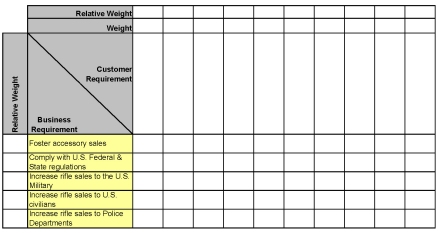
2. Enter the weightings given to the business requirements by the executive business team.
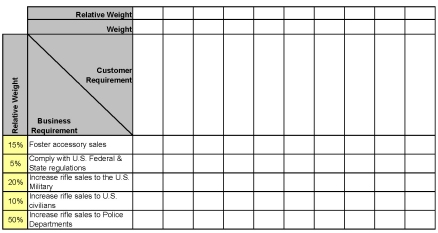
3. Enter all of the requirements from the various consumers into the horizontal requirements list (a.k.a. the “quality characteristics” or “how’s”, requirements list). Be sure to remove/combine any duplicates.
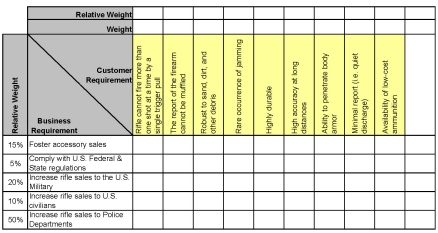
4. Add any requirements that were explicitly listed by the business executive team to the secondary requirements list.
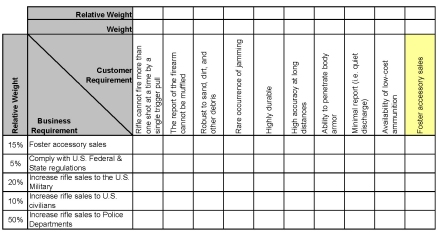
5. Enter the weightings assigned by the consumer groups into the appropriate ratings cells in the center of the matrix (i.e. the cells that correspond to the relevant consumer groups and their requirements).
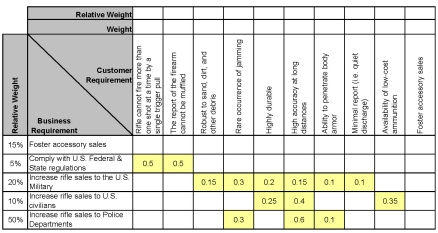
6. Enter a “1″ (i.e. 100%) in the rating cells that correspond to the requirements that were explicitly listed by the business executive team.
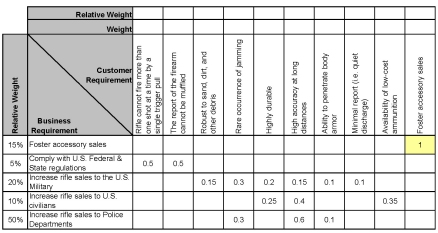
7. Calculate the weight values for the secondary requirements (i.e. the “customer requirements”) in the traditional fashion for a House of Quality, i.e. weight = SUM (all relationship values in the relevant column multiplied by the relative weight values in their corresponding rows)
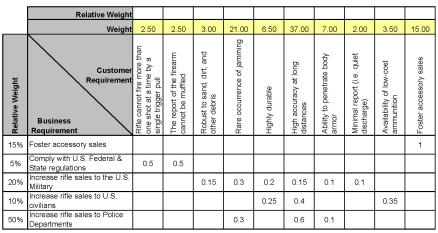
8. Calculate the relative weight values for the secondary requirements (i.e. the “customer requirements”) in the traditional fashion for a House of Quality, i.e. relative weight = weight / SUM (all secondary requirement weights in the HOQ). (This value indicates the weight of a given customer requirement relative to the weights of the other customer requirements.)
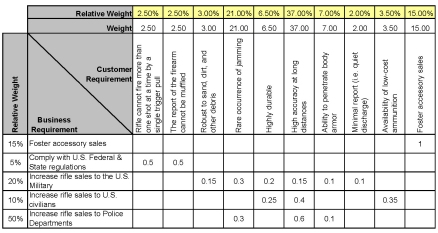
Note that the 2nd and 8th customer requirements are negatively correlated. Since the data is being entered into a House of Quality, that strong negative correlation can be appropriately documented in the “roof” of the HOQ.
This entry was posted on Wednesday, August 27th, 2008 at 9:00 pm and is filed under House of Quality, Advice, Voice of the Customer, Remodeling the HOQ™, Quality Function Deployment, QFD. You can follow any responses to this entry through the RSS 2.0 feed. You can also leave a response.



September 15th, 2008 at 10:29 am
In reviewing the contents of the website, I was trying to find suggested methods/approach for collecting “Demanded Quality” (aka Customer Requirements). I suppose methods include: face-to-face customer visits or perhaps internet surveys. Is anyone able to elaborate on how they have been successful in collecting Customer Requirements from a)direct consumers, and b)from business customers- which can be later used to begin the QFD exercise?
Thank you,
Scot